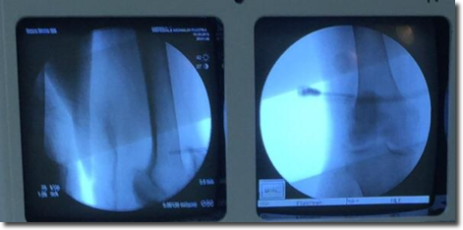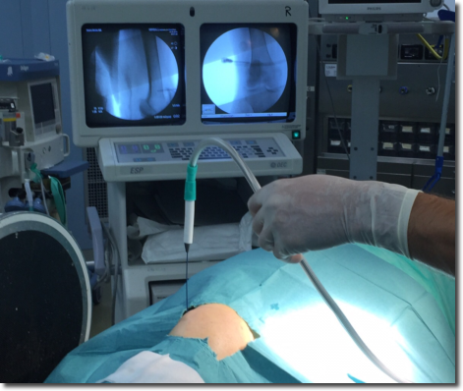Knee cooled radiofrequency vs continuous radiofrequency for genicular neurotomy: preliminary experience
Crio-radiofrequenza vs radiofrequenza continua
per neurotomia dei nervi genicolati: esperienza preliminare
Casi clinici
Pathos 2016; 23; 2. Online 2016, Sep 5
____________________________________________________________________
Alfonso Papa, Maria Teresa Di Dato, Pietro Buonavolontà,
Dario Tammaro, Andrea Pironti, Elisabetta Saracco, Maurizio Ferrara, Antonio Corcione
Dipartimento Area Critica- UOSD Terapia del Dolore AO dei Colli-V. Monaldi, Napoli
_____________________________________________________________________
Summary Radiofrequency neurotomy of genicular nerves has been often used as an efficacious treatment option in all patients suffering from chronic osteoarthritis pain to provide long-term pain relief. After providing informed written consent, 80 patients with severe knee chronic osteoarthritis pain had been enrolled; patients had been divided into two groups (Group C, crioneurolysis, vs Group R, traditional radiofrequency, 40 patients for each group). Pain relief in C group was poorer and with shorter time in duration (median NRS reducing from 8 to 5). Radiofrequency can be considered as an effective, minimally invasive treatment for these kinds of conditions, and offers the benefit of being a fast procedure with long-term pain relief.
Riassunto La neurotomia a radiofrequenza dei nervi genicolati è stata spesso adoperata come trattamento efficace in pazienti affetti da gonartrosi in quanto capace di indurre un buon controllo del dolore a lungo termine. Previa acquisizione del consenso informato, sono stati arruolati 80 pazienti con gonartrosi severa; sono stati suddivisi in due gruppi ( Gruppo C, crioneurolisi, vs Gruppo R, radiofrequenza tradizionale, 40 pazienti per ogni gruppo). Il controllo del dolore è stato minore e di minor durata nel gruppo C ( NRS mediana ridotta da 8 a 5). La radiofrequenza può essere considerata un trattamento efficace e mini-invasivo ed offre il vantaggio di essere una procedura rapida e caratterizzata da un buon mantenimento del risultato a lungo termine.
Key words Chronic pain, Osteoarthritis (OA), NRS, WOMAC, knee, cooled, radiofrequency
Parole chiave Dolore cronico, osteoartrosi, NRS, WOMAC score, ginocchio, crio-radiofrequenza
Introduction
Osteoarthritis (OA) is one of the most common causes of pain and functional impairment among the elderly and adults. OA is mainly a clinical diagnosis, but findings on radiographs, including joint space narrowing, subchondral sclerosis and osteophyte formation, are commonly used for epidemiological study purposes, even though there is often a discrepancy between radiographic changes and symptoms. Asymptomatic radiographic OA is common and knee pain IS due to knee OA not yet detectable on plain radiographs, as these changes may appear relatively late in the natural course of the disease. (2)
OA commonly affects the knee, with an a gender and sex-standardised incidence of 240/100 000 person-years. Over the age of 80 years, more than half of women and one-third of men suffer from radiographical OA of the knee.
The global prevalence of radiographically confirmed knee OA was recently estimated to be 3.8% (4.8% in females; 2.8% in males) with a peak at 50 years of age. These data are in agreement with the earlier observation that females are at a higher risk of knee OA than men. A recently published cross-sectional analysis found that women also experience greater knee pain than men, regardless of Kellgren-Lawrence grade. Pain, inflammatory flares, stiffness and loss of movement and function represent major symptoms of OA including knee OA, resulting in a substantial adverse impact on patients’ quality of life and considerable economic burden.
Materials and methods
Radiofrequency neurotomy of genicular nerves has been often used as an efficacious treatment option in all patients suffering from chronic osteoarthritis pain of knee when intra-articular or extra-articular pharmacologic therapies have failed. The application of cold to tissues creates a conduction block, similar to the effect of local anesthetics. Long-term pain relief from nerve freezing occurs because ice crystals create vascular damage to the vasonervorum, which produces severe endoneural edema. Cryoanalgesia disrupts the nerve structure and creates wallerian degeneration, but leaves the myelin sheath and endoneurium intact. Purpose of this study is to compare genicular neurotomy with cryoneurolysis vs. traditional RF. (1, 2, 5-12)
After providing informed written consent, 80 patients with severe knee cronic osteoarthritis pain had been enrolled (from January 2015 to January 2016), 48- 80 years – old, 34 males, 46 females. Exclusion criteria included chronic opioid use (regular use for longer than 3 months), and major prior ipsilateral open knee surgery. All patient had positive response to genicular anesthetic nerve block and no response to intra-articular pharmacologic treatments.
Clinical assessment had been realised with Numeric Rating Scale (NRS) and The Western Ontario and McMaster Universities Osteoarthritis Index (WOMAC score).
Median NRS was 8 and median WOMAC score about 81%.
Patient had been divided into two groups (Group C, crioneurolysis, vs Group R, traditional radiofrequency, 40 pts for each group)
After fluoroscopic positioning of needles and sensory and motor stimulation, C group had been treated with cryoneurolysis (at - 50°C for 2.30 minutes. No adverse events occurred during and after procedure. R Group had been treated with traditional radiofrequency for genicular neurotomy (+ 80°C for 5 minutes). Follow-up has been performed at 2, 4 and 12 weeks.
Nrs (mean) | Group C | Group R |
Baseline Follow up 2 weeks Follow up 4 weeks Follow up 12 weeks | 8,2 5,3 5,5 5,9 | 8,3 5,2 6,1 7,9 |
Womac (mean) | Group C | Group R |
| Baseline Follow up 2 weeks Follow up 4 weeks Follow up 12 weeks | 81% 36.4% 39.8% 40.2% | 83,3% 47% 48% 62.6% |


Conclusion
C group-patients reported pain relief for several months following this procedure. While some patients can report complete pain relief, this cannot be expected for all patients. In most patients,4 pain will be reduced to a more tolerable level. It can be considered as an effective, minimally invasive treatment for these kinds of conditions, and offers the benefit of being a fast procedure with long-term pain relief and, typically, a very short post-operative recovery period.
Conflict of interest
The authors certify the study was conducted without conflicts of interest.
Published
5th Septemper, 2016
Correspondence
marisita@libero.it
References
3) Di Dato MT et al. Knee cooled radiofrequency vs knee traditional radiofrequency (RF) for genicular neurotomy, Abstract book pg.126, 69° Congresso Nazionale della Società Italiana di Anestesia, Analgesia, Rianimazione e Terapia Intensiva (SIAARTI) Bologna, 14-17/10/2015.
6) Trescot AM, Noback CR. Cryoanalgesia in low back pain. In: Manchikanti L, Slipman C, Fellows B (ed.): Low back pain, diagnosis and treatment. ASIPP Press, Paducah, KKY 2002: 473-482
7) Schuster GD. The use of cryoanalgesia in the painful facet syndrome. J Neurola Orthopaed Surg 1982: 4: 271−274.
11) Brechner T. Percutaneous cryogenic neurolysis of the articular nerve of Luschka. Regional Anesth 1981; 4: 271−274.
12) Evans PJ, Lloyd JW, Green CJ. Cryoanalgesia: the response to alternations in freeze cycle and temperature. Br J Anaesth 1981; 53: 1121−1126.